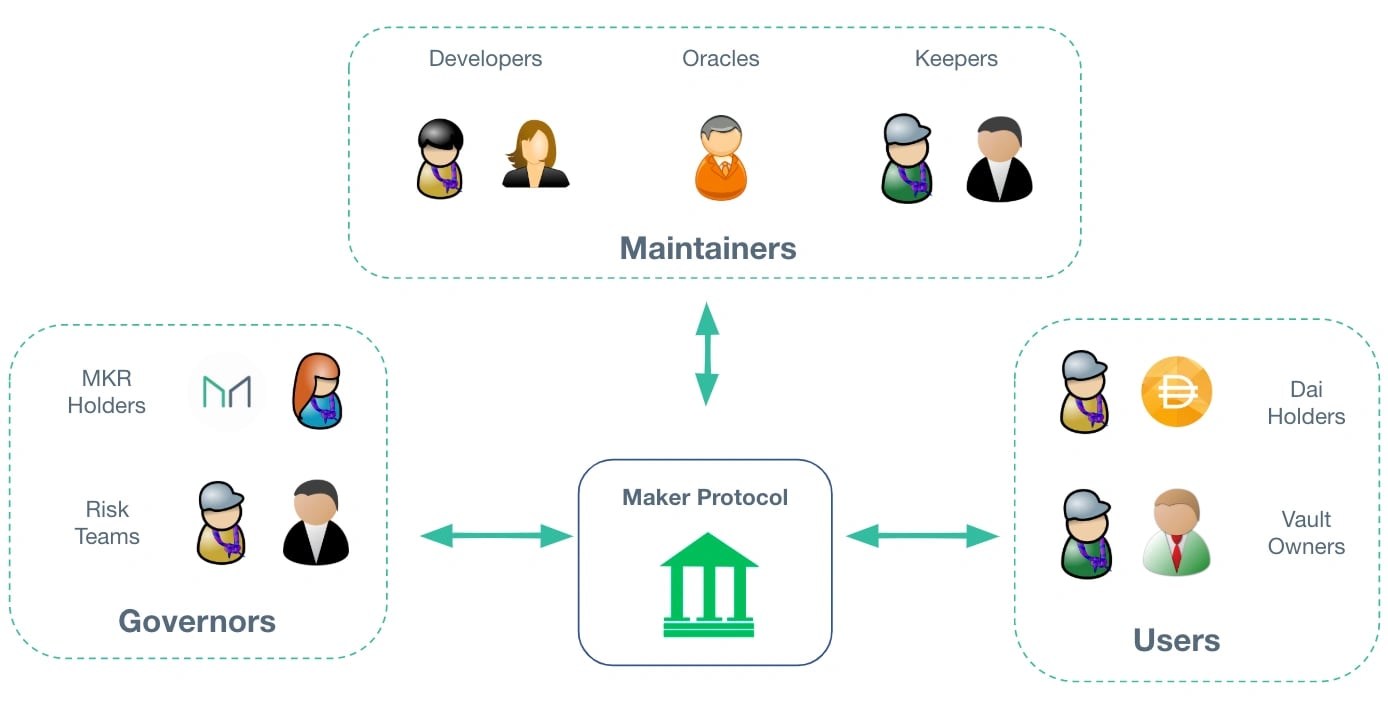订阅 wiki
Share wiki
Bookmark
MakerDAO
MakerDAO
MakerDAO 是一个去中心化的全球储备银行,在 Ethereum 区块链 上运行。它是一个开源项目和一个 去中心化自治组织 (DAO),由 Rune Christensen 于 2014 年创立。 [15]
概述
Maker协议利用以太坊智能合约提供一系列功能,包括其稳定币DAI的抵押和借贷,以及使用代币MKR进行治理。Maker协议自动化了这些流程,从而实现高效的金融系统。 [15][16]
Maker协议的运作方式是允许个人使用各种加密货币作为抵押品来获得DAI贷款。重要的是,这些贷款是超额抵押的,需要存入比贷款金额更多的加密货币。 [17]
需要超额抵押是为了防范ETH或支持DAI的底层代币(如Wrapped Bitcoin (WBTC) 和中心化的美元稳定币USDC和USDP)的潜在市场崩盘。 [17]
Maker协议
Maker协议,或多抵押Dai(MCD)系统,允许用户通过抵押Maker治理批准的抵押资产来生成DAI。该治理是一个社区运营的过程,负责监督Maker协议的各个方面。 [16]
Maker协议通过被称为Maker Vaults的智能合约创建新的DAI。这些智能合约可以通过各种Web界面和应用程序访问,例如Oasis Borrow和Instadapp。为了从智能合约中取回他们的抵押加密货币,用户必须偿还他们生成的Dai,以及稳定费。 [18]
外部代理
Maker协议的运作依赖于一些外部代理。 [23]
- Keeper: Keeper是一个自主实体,通过套利机会提供流动性并获得激励。
- 价格预言机: 该协议利用去中心化的预言机基础设施来获取Maker Vaults中持有的抵押资产的市场价格的最新信息。价格预言机对于确定启动清算的适当时间至关重要。
- 紧急预言机: 它们充当防御攻击平台治理或其他预言机的最后一道防线。
- DAO团队: DAO团队是由个人和服务提供商组成的团体,他们确保与治理相关的任务的正常运作。
治理
Maker协议由MKR代币进行治理。变更提案以智能合约的形式存在,任何以太坊地址都可以提交。MKR持有者社区对提案进行投票,拥有最多MKR批准票的以太坊地址将被授予实施对Maker协议的拟议变更的权力。[18]

链下治理
Maker的链下治理依赖于其在线资源,包括Maker DAO讨论论坛和Maker聊天应用程序。这些渠道允许任何个人提出和讨论想法,特别是在论坛上。通过这些渠道达成足够初步共识的想法可能会进入链上审议。 [24]
链上治理
Maker 使用两种主要的链上治理机制:治理投票和执行投票。[24]
治理投票每周持续进行,以衡量 MKR 持有者对各种主题的态度,包括那些经过广泛的链下讨论并正在考虑进一步决策的主题。然而,投票结果不影响协议的状态。[24]
执行投票是 MKR 持有者之间正式的链上投票,以决定对协议的更改。它们可以由任何平台利益相关者随时引入,但只有 MKR 持有者在执行投票期间拥有投票权。虽然执行投票可能基于治理投票的结果,但并非必须如此。Maker 已经建立了一种非正式的文化,即从链下讨论到治理投票再到执行投票的有序管道讨论。[24]
代币经济学
MKR 代币
MakerDAO 最初发行了 100 万个 MKR 代币。Maker 代币的总供应量和价值会根据市场情况和价格而变化。[18]

MKR 代币使其持有者能够投票决定协议的变更。如果启用了治理安全模块 (GSM),则对协议治理变量的批准修改可能不会立即生效,并且可能会延迟长达 24 小时。这种延迟使 MKR 持有者能够触发关闭并保护系统免受有害的治理提案的影响,例如那些改变抵押品参数或禁用安全措施的提案。[16]
DAI 代币
DAI 是一种 ERC-20 算法稳定币,旨在维持与美元一比一的比例。其主要目的是促进加密货币资产的借贷,而无需中间人。用户可以通过 MakerDAO 的 Oasis Borrow 仪表板开设抵押金库,并提供基于以太坊的资产作为抵押品来生成和借用 DAI。存入的抵押品价值必须始终高于发行的 DAI 代币的价值。如果抵押品的价值低于发行的 DAI 代币的价值,抵押品将被清算。 [25]
2023 年 7 月,MakerDAO 社区批准了一项旨在暂时提高稳定币 Dai 持有者利率的提案,将代币持有者的收益提高到高达 8%。该提案引入了增强型 Dai 储蓄利率 (EDSR),这是一种暂时提高用户可用的有效 Dai 储蓄利率 (DSR) 的机制。增强型机制将由 DSR 利用率决定,并将随着 DSR 利用率的上升而逐渐降低。 [35]
“EDSR 通过确保 Dai 持有者 [...] 从协议产生的更高回报中获得更公平的价值来帮助解决这个问题。反过来,这可能有助于刺激采用,”MakerDAO 联合创始人 Rune Christensen 的提案中写道 [35]
Maker Vaults
接受的抵押资产可以通过 Maker 协议中的 智能合约(称为 Maker Vaults)来生成 DAI。用户可以通过多种用户界面(例如 Oasis Borrow 以及社区创建的界面)访问 Maker 协议并建立 Vaults。生成 DAI 会产生偿还 DAI 以及支付稳定费的义务,以解锁存放在 Vault 中的抵押品。 [26]
Vaults 本质上是非托管的。用户可以直接与 Maker 协议和 Vaults 交互,并且只要抵押品的价值保持在要求的最低水平之上,他们就可以完全控制其存入的抵押品。 [26]
资金
在MakerDAO二级代币销售期间,该公司从多家投资者处筹集了资金。2017年12月16日,筹集了1200万美元,投资方包括Andreessen Horowitz、Polychain Capital以及其他公司,如Distributed Capital Partners、Scanate、FBG Capital、Wyre Capital、Walden Bridge Capital和1confirmation,平均价格为每个代币300美元。[20]
2019年4月,又进行了一次销售,筹集了1500万美元,a16z Crypto是主要投资者,平均价格为每个代币250美元。同月,MakerDAO又从Paradigm和Dragonfly Capital筹集了2750万美元。[20]
Maker基金会
Maker基金会是全球Maker社区的一部分,与各种合作伙伴合作,构建和启动Maker协议。该基金会目前正与MakerDAO社区合作,建立去中心化治理,并努力实现Maker协议和Dai的完全去中心化。Dai是一种基于以太坊区块链的去中心化、抵押品支持的稳定币,由MakerDAO管理。 [16][19]
可持续发展努力
MakerDAO 提出了一项治理章程,其中包括在 2040 年之前用 20,000 个 MKR 代币(约 1400 万美元)资助可持续发展活动。该章程由创始人 Rune Christensen 撰写,将“科学可持续性”作为 Maker 政治和运营的核心原则。 [22]
“在 Maker 章程制定之时,世界正走向悬崖,失控的温室气体污染将生物圈推过关键的气候临界点,这将导致几个世纪的灾难。需要立即采取行动” - Maker 章程的初步草案
MakerDAO 治理章程草案仍在进行中,并将不断更新。该提案需要通过征求意见 (RFC) 阶段,社区目前正在审查并提供反馈。RFC 阶段至少持续 4 个月,之后 Christensen 可以将提案提交到治理周期,供社区评估和投票。 [22]
MakerDAO x Chainlink
MakerDAO 将 Chainlink 的智能合约自动化整合到其 Keeper 系统中。Chainlink 自动化执行更新价格、平衡 DAI 直接存款模块 (D3M) 的流动性以及提高抵押资产的债务上限等功能。 [27]
“这个自动化机器人网络执行维护 Maker 协议的基本任务,并将通过与 Chainlink 著名的、高度可靠的自动化平台的集成而大大扩展” - Nadia Álvarez,MakerDAO 增长核心单元成员
MakerDAO x Spark Protocol
MakerDAO发布了一个名为Spark Protocol的借贷平台和流动性市场,它是Aave版本3的一个分支。Spark Protocol是一个应用程序界面,旨在让用户能够借贷和质押DAI。为了在可能的漏洞或中断情况下增强安全性,由Chronicle Labs和Chainlink提供的定价预言机(数据来源)将支持新的协议。 [28][29]
Spark Lend是该平台的主要产品。它允许用户以现有的DAI储蓄利率1%借入DAI。Spark Lend将接受具有高流动性的去中心化资产,包括ETH、DAI、wstETH(质押ETH的封装衍生品)和wBTC(封装BTC)作为抵押品。预计该平台未来将推出更多功能,包括固定期限收益产品以及集成Maker的合成流动性质押衍生品EtherDAI。 [28][29]
MakerDAO 5阶段 Endgame 更新
Endgame 计划是一项改革和改进 Maker 生态系统治理和代币经济学的提案。正如 Christensen 在 2023 年 5 月的一篇论坛帖子中概述的那样,Endgame 更新的直接目标是在未来三年内促进 MakerDAO 稳定代币 DAI 的广泛采用,同时保持平衡的治理结构。[30]
为了实现这一目标,他建议 MakerDAO 应继续实施 Endgame 详细的五阶段路线图。
第一阶段:Beta 发布
根据 Christensen 的说法,Endgame 的初始阶段涉及建立一个全新的统一品牌。该品牌将拥有自己的稳定币和治理代币,与 DAI 和 MKR 不同。Maker 和 Dai 是加密货币行业内知名且信誉良好的品牌。 "遗憾的是,这种方法存在一些缺点,例如存在两个不同的品牌,而不是一个统一和连贯的概念," 他说。
可访问性治理流程的持续努力涉及重新设计 MakerDAO,旨在通过建立一个有凝聚力和统一的品牌来解决碎片化问题。根据 Christensen 的说法,持有 DAI 和 MKR 代币的个人可以选择保留他们的代币或过渡到新的稳定币和治理代币。[31]
第二阶段:SubDAO 启动
在 Beta 启动后,计划建立六个 Maker SubDAO,每个 SubDAO 都配备各自的治理代币。SubDAO 的开发目的是在保持与协议的任务联系的同时,独立于 Maker 运营。 [31]
2023 年 9 月 12 日,在首尔举行的 SubDAO Genesis 活动中,向韩国社区推出了 4 个 SubDAO。
SakuraDAO - 作为一个 SubDAO 推出,旨在赚取 DeFi 收益;SparkDAO - 通过 SPK 代币管理 Spark 协议的社区;QuantitativeDAO - 开创了数十亿美元公共信贷 RWA 的代币化;最后,QualitativeDAO - 一个去中心化的社区,旨在通过有形资产(如房地产)的代币化,将公共和私人信贷引入链上。 [32]
第三阶段:治理AI工具启动
创建并启动由AI驱动的治理工具将是Endgame路线图的第三阶段。该引擎旨在保证新的治理代币的持有者有强烈的动机积极参与治理过程。 [31]
第四阶段:治理参与激励启动
射手座锁定质押引擎(SLE)的引入代表了Endgame路线图的第四阶段。该引擎旨在保证新的治理代币的持有者有强烈的动机积极参与治理过程。 [31]
第五阶段:新链启动和最终终局状态
Endgame路线图的最后阶段是启动一个重新命名的新链。Christensen强调,这一状态将在MakerDAO的基本运营中建立持久的平衡、去中心化和可持续性。这个新的区块链旨在作为所有后端工具的中心枢纽,以促进MakerDAO的功能。[31]
团队
MakerDAO 团队组成:[21]
- Rune Christensen – 创始人
- Derek Flossman – 协议工程负责人
- Phil Inje Chang – 产品负责人
- Andrew Chorlian – 区块链开发者
- Michael Elliot – 区块链工程师
- Krzysztof Kaczor – 高级软件工程师
- Matthew C. – 业务发展经理
争议
2023年8月,MakerDAO阻止虚拟专用网络(VPN)用户访问其借贷平台Spark Protocol,这引发了社区的批评。[33]
去中心化和隐私倡导者Blec在X(前身为Twitter)上发文,批评MakerDAO的创始人Rune Christensen以及开发者,并在回复推文中表示,他们将利润置于用户隐私之上:
“问题的根源在于这些开发者将利润置于原则之上。他们将自己的银行账户余额置于您的隐私和权利之上。” Blec发推文表示[33]
SPK farming和SakuraDAO的DeFi收益不向美国或VPN用户开放。[34]
发现错误了吗?
